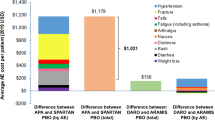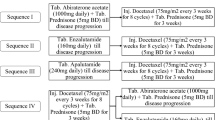Summary
Objective
In Italy, the standard curative treatment for prostate carcinoma with metastases is the androgen suppression therapy (AST). Recently, intermittent AST has been introduced for the treatment of androgen-responsive patients aged > 75 years in order to reduce the toxicity and cost of treatment, as well as to delay tumor progression. The purpose of this study was to perform a cost-analysis of standard AST, intermittent AST or bilateral surgical castration.
Patients and setting
A total of 584 patients from the ULSS 9 (district of Treviso, Veneto, Italy) treated with AST, examined in 1999.
Main outcome measures
Parameters adopted in this study were drug prescriptions, length of treatments, biochemical assays and costs of hospital stay.
Results
The patients exposed to AST represented 0.33% of the whole male population of the district. Two hundred and sixty-one subjects were aged > 75 years. The largest proportion of the treated population was 78 years-old. Eighty patients had been receiving AST for more than 6 years, and during the year 1999 approximately 50% of them were not prostate-specific antigen (PSA)-tested.
Cost-analysis
The yearly treatment cost for prostate cancer per patient was € 3,823.46 as assessed in 1999. In order to reduce costs, three scenarios can be considered: a) with the cheapest AST drug (triptorelin, 11.25 mg), the estimated cost would be € 3,495.09 patient/year, b) with surgical castration, the estimated cost would be lower (€ 2,268.98 patient/year), and finally c) treatment with intermittent AST of patients > 75 years, previously treated with AST for at least 1 year, would cost € 2,525.30 patient/year.
Conclusions
In addition to its reduced toxicity, intermittent AST should be extensively considered for use because of the reduced cost of AST therapy, which would be similar to the cost of surgical castration.
Similar content being viewed by others
Bibliografia
Boyle P, Gandini S, Baglietto N, et al. Epidemiology of prostate cancer. Eur Urol 2001; 39(S4): 2–3
Goldemberg SL, Gleave ME, Bruchousky N. The role of intermittent androgen suppression in prostate cancer. AUA Update Series 1999; 18: 18
Bouchot O, Lenormand L, Karam G, et al. Intermittent androgen suppression in the treatment of metastatic prostate cancer. Eur Urol 2000; 38: 543–9
Theyer G, Hamilton G. Current status of intermittent androgen suppression in the treatment of prostate cancer. Urology 1998; 52; 353–9
WHO Collaborating Center for Drug Statistic Methodology Guidelines for ATC classification and DDD assignment. Oslo; WHO 2000.
Insirello L, Ballerini L, Brogna F. Gonadoreline di sintesi nel carcinoma prostatico: valutazione comparativa e farmacoeconomica dell’impiego clinico. Giornale Italiano di Farmacia Clinica 2002; 16: 30–4
Bray F, Sankila R, Ferlay J, Parkin DM. Estimates of cancer incidence and mortality in Europe in 1995. Eur J Cancer 2002; 38: 99–166
Boyle P, Severi G. Epidemiology of prostate cancer chemoprevention. Eur Urol 1999; 35: 370–6
Surveillance, Epidemiology, and Results (SEER) Program. Age-adjusted U.S. cancer death rates. J Natl Cancer Inst 1997; 89: 12
Parkes A, Killer G. Prostate-specific antigen — is it already being used as a screening test? Med J Aust 1994; 161: 722–3
Ward JE, Hughes A-M, Hirst GHL, Winchester L. Men’s estimates of prostate cancer risk and self-reported rates of screening. Med J Aust 1997; 167: 250–3
McCredie M. A rising incidence of prostate cancer in Australia: effect of “screening” or more disease? Cancer Forum 1995; 19: 7–12
McCaul K, Luke C, Roder D. Trends in prostate cancer incidence and mortality rates in South Australia. Med J Aust 1995; 162: 520–2
Buserelin Depot, nel carcinoma della prostata. Min Urol & Nefrol 1995; 47: S1
LaRosa JH, LaRosa JC. Enhancing drug compliance in lipid-lowering treatment. Arch Fam Med 2000; 9: 1169–75
Avorn J, Monette J, Lacour A, et al. Persistence of use of lipid-lowering medications. JAMA 1998; 279:1458–62
Andrade SE, Walker AM, Gottlieb LK, et al. Discontinuation of antihyperlipidemic drugs — Do rates reported in clinical trials reflect rates in primary care settings? N Engl J Med 1995; 332: 1125–31
Seidenfeld J, Samson DJ, Hasselblad V, et al. Single-therapy androgen suppression in men with advanced prostate cancer: a systematic review and meta-analysis. Ann Intern Med 2000; 132: 566–77
Nicol DL, Heathcote PS, Kateley GD, Lloyd S. Advanced prostate cancer. The role of high priced hormone therapy. Med J Aust 1993; 159: 16–9
Bonzani RA, Stricker HJ, Peabody JO, Menon M. Cost comparison of orchiectomy and leuprolide in metastatic prostate cancer. J Urol 1998; 160: 2446–9
Chon JK, Jacobs C, Naslund MJ. The cost value of medical versus surgical hormonal therapy for metastatic prostate cancer. J Urol 2000; 164: 735–7
Bayouni AM, Brown AD, Garber AM. Cost-effectiveness of androgen suppression therapies in advanced prostate cancer. J Natl Cancer Inst 2000; 92: 1731–9
Mariani AJ, Glover M, Arita S. Medical versus surgical androgen suppression therapy for prostate cancer: a 10-year longitudinal cost study. J Urol 2001; 165: 104–7
Grossfeld GD, Small EJ, Carroll PR. Intermittent androgen deprivation for clinically localized prostate cancer: initial experience. Urology 1998;51:137–44
Horwich A, Huddart RA, Gadd J, et al. A pilot study of intermittent deprivation in advanced prostate cancer. Br J Urol 1998; 81: 96–9
Theyer G, Hamilton G. Current status of intermittent androgen suppression in the treatment of prostate cancer. Urology 1998; 52: 353–9
Bouchot O, Lenormand L, Karam G, et al. Intermittent androgen suppression in the treatment of metastatic prostate cancer. Eur Urol 2000; 38: 543–9
Kurek R, Renneberg H, Lubben G, et al. Intermittent complete androgen blockade in PSA relapse after radical prostatectomy and incidental prostate cancer. Eur Urol 1999; 35: 27–31
Strum SB, Scholz MC, McDermed JE. Intermittent androgen deprivation in prostate cancer patients: factor predictive of prolonged time off therapy. The Oncologist 2000; 5: 45–52
Da Silva F, Bono A, Whelan P, et al. Phase III study of intermittent MAB versus continuous MAB international cooperative study. J Urol 2001; 165: 292–8
Stekyi-Mensah E, Hart K, Bolton S, Formanh J. Intermittent androgen deprivation therapy for recurrent prostate concer. J Urol 2001; 4(S): 169–73.
Author information
Authors and Affiliations
Corresponding author
Rights and permissions
About this article
Cite this article
Salvato, C., Terrazzani, G., Serraglia, D. et al. Analisi delle prescrizioni farmaceutiche e dei costi del trattamento del carcinoma prostatico nell’ULSS 9 di Treviso. Pharmacoeconomics-Ital-Res-Articles 5, 35–43 (2003). https://doi.org/10.1007/BF03320602
Published:
Issue Date:
DOI: https://doi.org/10.1007/BF03320602




